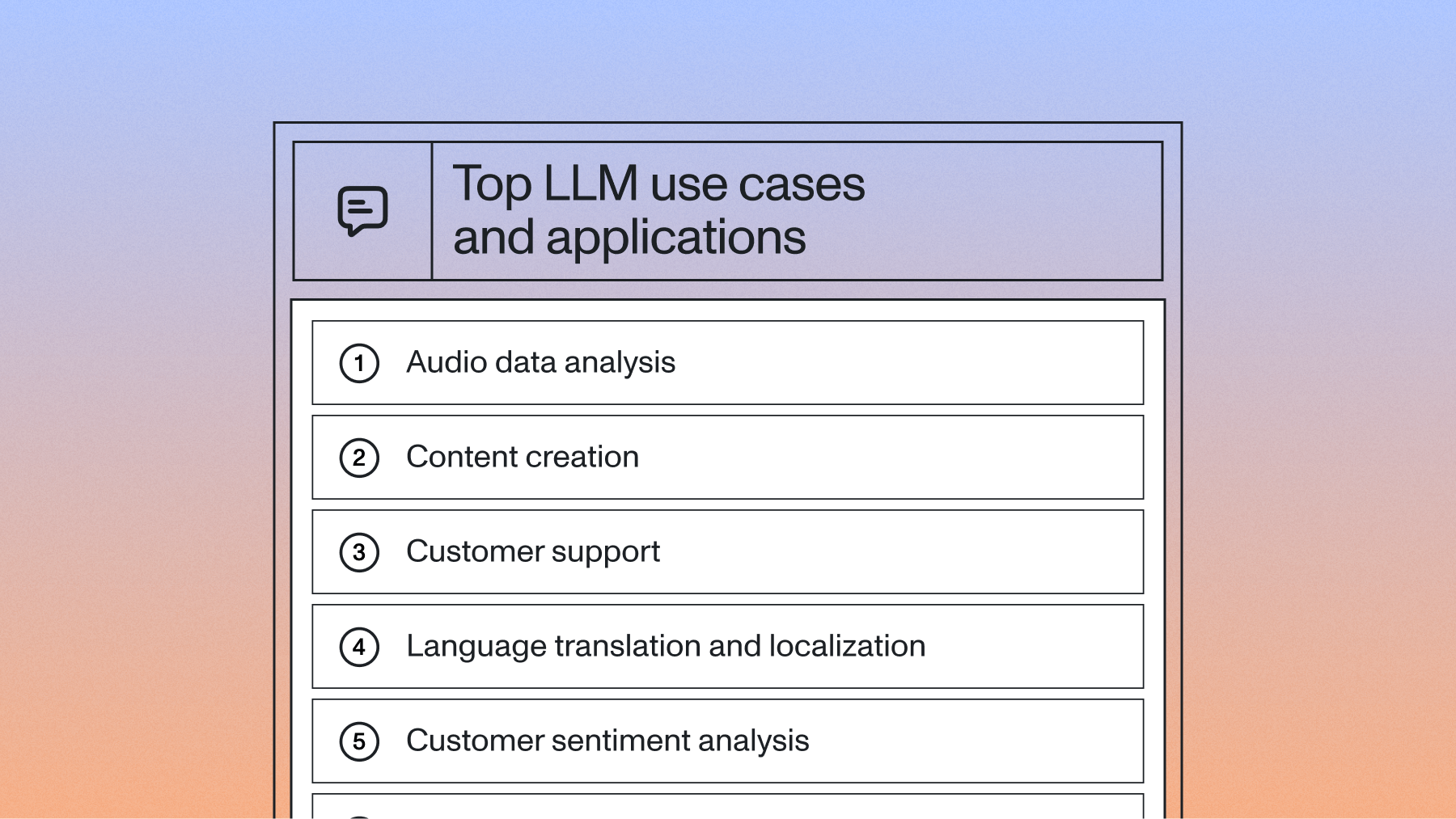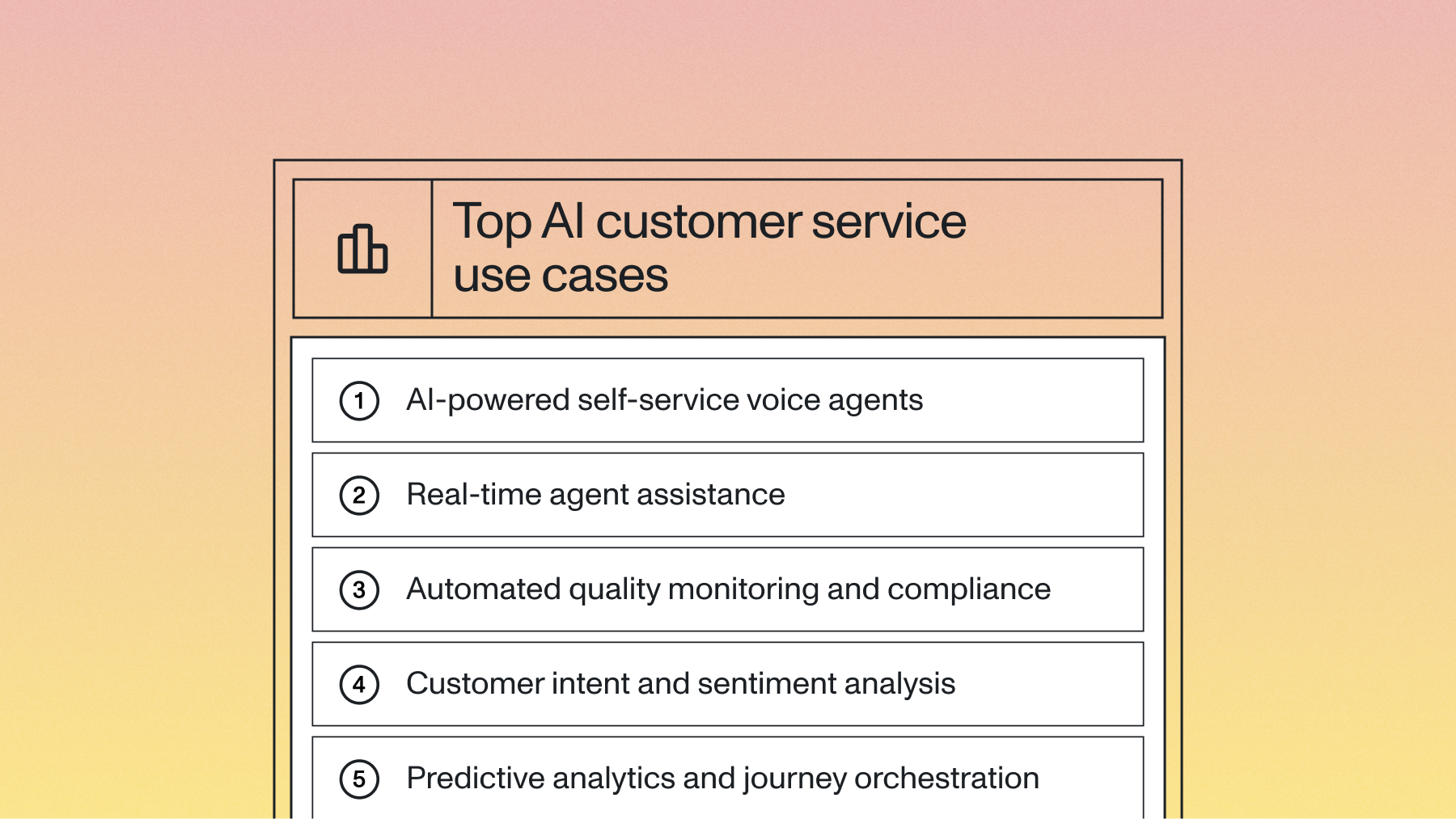Conversation intelligence: How to better understand the voice of the customer with Speech AI
Explore how Speech AI models can help build better voice of customer tools for conversation intelligence platforms.



Finding the right customer service representative can range from frustrating to infuriating for many consumers. Being forced to repeat their problems and questions multiple times as they get passed off to different departments sends a message that customer experience isn’t a top priority and neither is meeting the basic needs of those customers. The exchanges can feel cold and impersonal, souring relationships with businesses, sometimes before they even start.
These experiences are not an anomaly: More than 60% of consumers in 2023 felt that most companies treated them like a number. And B2B customers weren’t feeling much better. About 60% of business buyers said sales representatives weren’t taking the time to get to know them, while more than 70% said that their interactions felt transactional.
That is risky behavior for companies in today’s marketplace. More and more, consumers are showing a willingness to switch brands, so relying on customer loyalty isn’t a safe bet.
To help achieve better consumer satisfaction, many companies are turning to conversation intelligence platforms that combine voice of customer data and AI analysis to better understand their customers’ needs and experiences and produce better engagement in the long term.
In this blog post, we’ll discuss what this means in further detail, and how Speech AI models can be used to build more robust voice of customer tools for conversation intelligence platforms.
Play around with Speech AI models for conversational intelligence in our no-code playground
The power of personalization in customer service
For businesses that want to build strong relationships with their customers or take advantage of shifting marketplace dynamics to attract new customers, personalization is key. That doesn’t just mean sending discount codes to buyers on their birthdays.
Companies must be able to accurately assess and anticipate how their customers preferences are changing and tailor their experiences to meet those needs. Consumers want timely assistance from humans, and service should be consistent no matter which representative a customer interacts with.
A comprehensive strategy to create personalized customer service and customer experiences can not only help companies build their customer base, but also create advocates that lead to new business opportunities. But in order to excel at personalization strategies, businesses need to collect and use the right data effectively. And, they need to share it across teams.
However, teams that are collecting a lot of data aren’t always sure if they’re using data effectively. For example, marketers have a range of tools at their disposal, including marketing analytics and measurement tools, customer relationship management platforms, and customer data platforms, but two-thirds are unsatisfied with how they are using customer data to create relevant experiences for their buyers, leaving significant room for improvement.
Putting the voice of the customer first
Businesses need to think more critically about the types of data that can support the development of personalized experiences.
While business intelligence teams can make insightful observations by analyzing how customers interact with sites and what journeys they take to make a purchase, Voice of the Customer (VOC) programs can also play a crucial role in learning about customer preferences, needs, and problems.
Within VOC programs, surveys and questionnaires are common tools, providing structured data on customer satisfaction and preferences. In-depth interviews and focus groups offer qualitative insights, allowing businesses to understand the nuances of customer expectations. Social media monitoring and sentiment analysis can also capture real-time feedback and broader public opinion.
However, customers are giving less feedback to companies, particularly if they are dissatisfied with a service or product. Instead, they may drop the product or service altogether, completely disengaging and leaving companies with little to no feedback on what went wrong. Capturing customers’ voices will therefore require more creative new listening tools.
Conversation intelligence platforms are integrating Speech AI to help companies solve these data management problems, unlock voice of customer insights and, ultimately, drive more intelligent customer interactions.
Here’s how:
Unlocking customer insights with Speech AI and conversation intelligence tools
Speech AI models can be used to swiftly transcribe conversations into text and perform sophisticated analysis on this conversational data.
Speech AI models (including Speech-to-Text AI and LLMs for speech) can perform tasks such as:
- Transcription
- Speaker diarization
- Profanity filtering
- Automatic language detection
- Summarization
- Sentiment analysis
- Topic detection
- PII redaction
Companies can use these AI models to build powerful conversation intelligence tools and platforms designed to support VOC programs that inform sales, customer support, and other teams across the company. Instead of relying on time-consuming or costly surveys and focus groups, each customer service or sales interaction instantly becomes a valuable source of data that can drive informed decision-making and strategic improvements.
For example, using Speech AI models, Echo AI developed conversation intelligence tools that showcase what this visibility can mean for business leaders and managers. With Echo AI’s tools, users can summarize customer conversations, flag key terms like “cancel my subscription” and identify the overall sentiment of both participants in sales calls or customer support interactions. This data can be used to monitor individual accounts and address specific service needs, or be pooled into larger data sets that allow companies to answer questions like, “What are the main causes of customer churn this quarter?”
Conversation intelligence data and insights can also be integrated into platforms that house other forms of customer and sales data, enabling leaders to generate a holistic view of their business and to more effectively share insights across teams and departments. Every touch point can then be tailored to the unique experience of a consumer.
10 benefits of conversation intelligence for business
Companies are combining voice data with Speech AI models to create robust conversation intelligence tools with numerous downstream benefits for customers, such as:
- Improved customer service
Conversation intelligence can identify common issues and pain points experienced by customers. This information helps train customer service representatives to handle inquiries more efficiently and provide better support.
- Sales optimization
By analyzing sales calls and interactions, businesses can uncover successful sales tactics and areas for improvement. Sales teams can use these insights to refine their strategies, leading to higher conversion rates and increased sales.
- Training and development
Conversation intelligence tools can highlight best practices and areas where employees need improvement. Businesses can use this data to develop targeted training programs, enhancing overall employee performance.
- Product feedback
These platforms capture direct customer feedback during conversations, providing valuable insights into what customers like or dislike about products. This feedback can guide product development and innovation.
- Marketing strategy enhancement:
By understanding the language customers use and responses they have to certain phrases, businesses can craft more effective marketing messages. Conversation intelligence helps identify key themes and trends that resonate with customers, improving marketing campaign effectiveness.
- Customer retention:
Identifying early signs of customer dissatisfaction through conversation analysis allows businesses to address issues proactively, reducing churn, and improving customer loyalty.
- Quality assurance:
Regular monitoring and analysis of customer interactions ensure that service quality remains high. Businesses can quickly identify and correct any deviations from established service standards.
- Competitive analysis:
By analyzing customer conversations, businesses can gain insights into how their competitors are perceived. This information can inform strategic decisions and help companies stay ahead of the competition.
- Real-time insights:
These platforms provide real-time data and analytics, enabling businesses to make informed decisions swiftly. This agility is crucial for promptly responding to customer needs and market changes.
- Personalized customer experiences:
Understanding individual customer preferences and histories through conversation analysis allows businesses to personalize interactions, enhancing customer satisfaction and loyalty.
Tailoring customer experiences with AI and human touch
When it comes to customer interaction, hearing a human voice that recognizes and empathizes with a customer’s challenges makes a difference. Speech AI and conversation intelligence tools can augment companies to help their customer service representatives better understand customers' needs and pain points and create personalized experiences that keep customers satisfied in the long run.
Additional Conversational Intelligence reads
- Top 6 benefits of integrating LLMs for Conversation Intelligence platforms
- How CallRail doubled its Conversation Intelligence customers by building with a trusted AI partner
- AI-powered call analytics: How to extract insights from customer conversations
- Conversation intelligence: How to better understand the voice of the customer with Speech AI
- What is Conversational Intelligence AI?
- Enterprise conversation intelligence
- Best conversation intelligence software
- 3 easy ways to add AI Summarization to Conversation Intelligence tools
Lorem ipsum dolor sit amet, consectetur adipiscing elit, sed do eiusmod tempor incididunt ut labore et dolore magna aliqua. Ut enim ad minim veniam, quis nostrud exercitation ullamco laboris nisi ut aliquip ex ea commodo consequat. Duis aute irure dolor in reprehenderit in voluptate velit esse cillum dolore eu fugiat nulla pariatur.






